These installation instructions provide essential information for installing VESDA VLF Aspirating Smoke Detectors in accordance with the system design. Additional installation and
product documentation is listed below in the Reference Documents section.
System Components
The detector is shipped with the following components:
• 1 VESDA VLF detector with tted exhaust deector
• 1 mounting bracket
• 1 End of Line resistor for the monitored GPI
• 12 M4 x 20 mm locking screws
• 1 installation instruction sheet
• 1 product guide
Prerequisites
• A completed system design documents.
• A 24V DC Power Supply, compliant with local codes and standards.
• Screws and inserts that are appropriate for the mounting suface.
• 9 Pin DB9 PC COM Serial extension cable (male) for initial conguration of the
detector.
• Labels as specied in the system design.
• Cable glands that are compliant with the IP rating of the detector.
• Conduit, as specied in the system design.
• 0.2 mm
2
to 2.5 mm
2
(24 - 14 AWG) wiring for relays.
• A PC or laptop installed with Xtralis VSC for initial conguration.
• Standard connection instructions for where the detectors are to be added to a corporate
network.
Standards Compliance
UL
For open area protection the re alarm threshold (signal) that initiates an evacuation
procedure via the Fire Alarm Panel must not be set less sensitive than 0.625%/ft. The
detector can send this signal via the Fire Alarm Panel Output signal or the Pre-alarm
output signal.
Through validation testing, Underwriters Laboratories Inc. has veried that VESDA ECO
gas detectors, when installed within the sample pipe network, present no signicant
effects on the smoke detection performance of VESDA. The use of the ASPIRE calculation
software is required to verify system design performance with all devices included in the
design.
European Installations
The product must use a power supply conforming to EN54: Part 4.
The product is compliant with EN 54-20 sensitivity requirements provided the following
conditions are met:
• For a Class A detector, hole sensitivity must be better than 1.5% obscuration/m and
transport time less than 60 seconds for VLF-250 direct sampling and 90 seconds for
VLF-250 capillary sampling or VLF-500
• For a Class B detector, hole sensitivity must be better than 4.5% obscuration/m and
transport time less than 60 seconds for VLF-250 direct sampling and 90 seconds for
VLF-250 capillary sampling or VLF-500
• For a Class C detector, hole sensitivity must be better than 10% obscuration/m and
transport time less than 60 seconds for VLF-250 direct sampling and 90 seconds for
VLF-250 capillary sampling or VLF-500
These limits should be veried using ASPIRE during the design of the sampling pipe
network.
The product is compliant with EN 54-20 ow monitoring requirements provided the
following conditions are met:
• The minor low and minor high ow thresholds should be set at 80% and 120%
respectively
• The ow through the detector predicted by ASPIRE should be in the range 12 to
54 lpm.
Power Consumption (24 VDC Supply)
VLF-250: 220 mA nominal, 295 mA in alarm
VLF-500: 410 mA nominal, 490 mA in alarm
Environmental Requirements
• Temperature
• Ambient: 0°C to 39°C (32°F to 103°F)
• Sampled Air: -20°C to 60°C (-4°F to 140°F)
• Tested to: -10°C to 55°C (14°F to 131°F)
• UL :0°C to 38°C (32°F to 104°F)
• Humidity: 5% to 95% RH, non-condensing
Note:
Please consult your Xtralis representative for information on operation outside
these parameters or where sampled air is continually above 0.05% obs/m
(0.015% obs/ft) under normal operating conditions.
Reference Documents
Additional installation and product information is contained in the following documents,
which are available for download in the Xtralis partner extranet at www.xtralis.com.
• 07209 - VESDA VLF-500 Product Guide
• 07208 - VESDA VLF-250 Product Guide
Installation Instructions
Notes
The VESDA-detector can be mounted in an upright
or inverted position. Do not mount the detector with
a sideways orientation.
Ensure the mounting surface is at as this allows an
air tight seal to be achieved between the sampling
pipe and the tapered air inlet pipes on the detector.
Refer to the detector Product Guide for information
on inverted mounting.
Ensure that there is sufcient clearance to mount
the detector, noting the location of air sampling
pipes and cable entry points. Due to the rigid nature
of the plastic pipe, installation must provide for
sufcient movement in all pipework (air inlet, air
exhaust and cable pipes) to allow pipe ends to be
easily tted and removed.
• A: Minimum 200 mm (8 in.) below ceiling
level.
• B: Min. 500 mm (20 in.) from a wall or
obstruction to allow access to the security
tab
Installation Procedure
A. Position the air inlet centerline mark (A) of the mounting bracket against the end of
the air inlet pipe.
B. In the cut out section of the mounting bracket mark a line across the top of the cut out
if metric size pipe is used or mark a line across the bottom of the cut out if Imperial
size pipe is used
C. Slide the mounting bracket down (up for inverted mounting) until the top of the
bracket aligns with the marked line
D. Mark off and drill the 2 bracket mounting holes (H).
E. Screw the bracket to the wall.
F. Hook the smoke detector onto the mounting bracket tabs and pull it down into
place
G. Use the two M4 x 20 mm locking screws provided and screw them into the screw
holes on the left andright side of the detector. See the items marked (F) in below
gure.
H. The air sampling pipe can now be attached and power connected.
VESDA VLF-250 and VLF-500 Installation Instructions
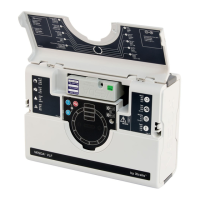
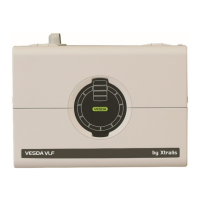
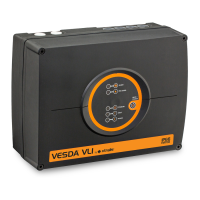

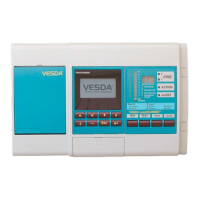
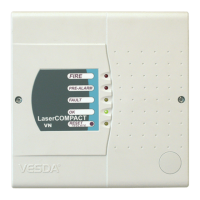
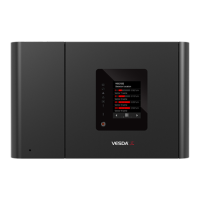
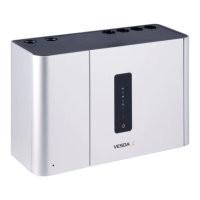
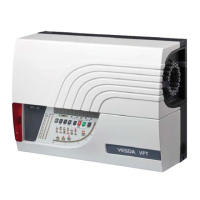
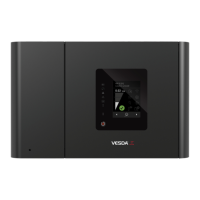
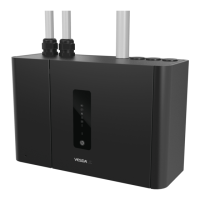
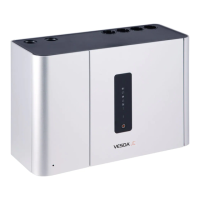

